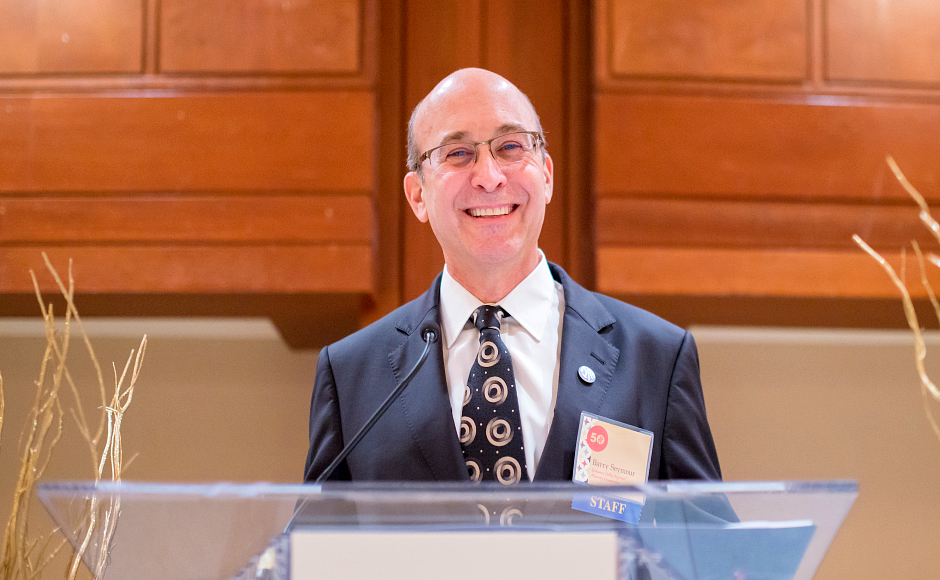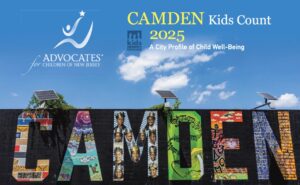The Delaware Valley Regional Planning Commission has begun its search for a new executive director, as Barry Seymour retires from the organization after 16 years as its leader. Seymour joins us for a chat about his experiences, regional planning challenges, and what his successor should know about the job.
By Matt Skoufalos | October 3, 2022
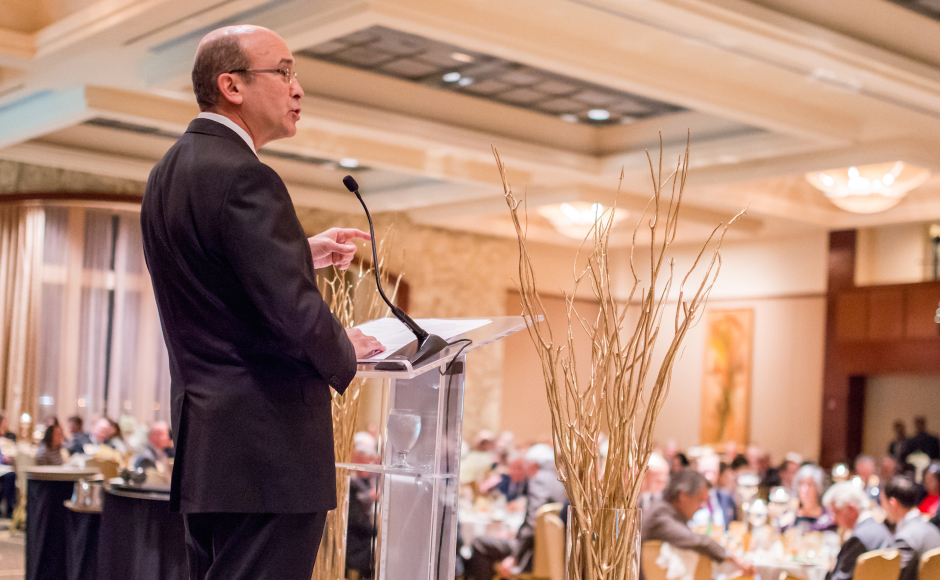
DVRPC Executive Director Barry Seymour is retiring from the organization after 32 years. Credit: DVRPC.
Barry Seymour moved from New York to Philadelphia at the end of 1990 to take a strategic planning position with the Delaware Valley Regional Planning Commission (DVRPC).
At the time, he thought he might be with the organization for a year. Now, he’s preparing to retire as its executive director.
In all, Seymour has spent 32 years with DVRPC, and 16 atop its leadership structure, after succeeding John Coscia as executive director in 2006.
As the organization begins its search for his replacement, we asked Seymour to share his thoughts on DVRPC, the greater Philadelphia metro region, and the time he’s spent as a custodian of the futures of both.
This interview has been edited for length and clarity.
NJ PEN: You’ve spent more than 30 years with DVRPC. How have things in the region and the organization changed in that time?
BARRY SEYMOUR: When I came in 1990, Philadelphia was really struggling. It was a city that had been losing population for decades. There was not a lot of growth opportunity. Businesses had been moving out. And there was a disconnect between the suburban environment and the city. You were seeing a lot of suburban sprawl, and eating-up of farmland.
I think DVRPC has always been a professional organization, but I don’t think we were as connected across the region at that point. Over time, as we started programs supporting growth in the older suburbs, programs that would bring communities together for shared services, I think our role has grown.
DVRPC has taken on more of an outreach role; a direct-assistance role; and an active role in terms of working with communities across the region.
NJ PEN: As Philly lost population in the timeframe you described, suburban sprawl overtook South Jersey. Communities like Cherry Hill and Washington Township sprang up from unincorporated farmland with little centralized organization. How do you account for the shift in vision that created those communities versus the ones that today are re-orienting around Main Street downtowns and central business districts?
SEYMOUR: There was a time when there was a general cultural push to get your piece of land; a little bit of the American frontier ideal. “Let’s move on and stake our claim, even if it’s just in Washington Township and not in the Wild West.” It’s not unique to this region. It happened in every city in the country as the suburbs grew, and highways grew to support that. The U.S. is still a very car-driven culture.
People that moved to the suburbs realized, “Maybe we have a bigger house and another car, but maybe it’s a little lonely. Maybe we don’t know our neighbors. Maybe we don’t want to have to drive everywhere to do anything. Maybe it would be nice if our kids could ride their bikes somewhere, and see friends without us having to drive them.”
After the kids were grown, they started moving back into the city. But those kids who grew up in the suburbs maybe realized if you’re young, and single, and eager to meet people, the odds are better in a higher-density, mixed-use neighborhood.
At the same time, there were public investments that made those [urban] places more attractive. There were investments in parks, and green space, and common open space, where people could convene and get together.
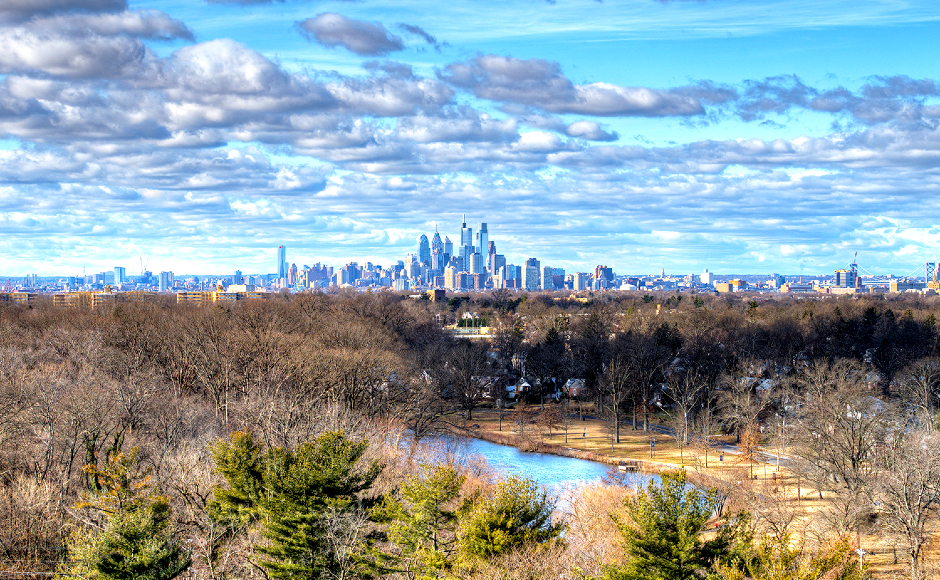
The DVRPC includes nine counties in NJ and PA that comprise the Philadelphia metro area. Credit: DVRPC.
NJ PEN: For those who aren’t familiar with the DVRPC, how do you describe the role of the organization within the Philly metro area?
SEYMOUR: Our role as the metropolitan planning organization is to prepare a long-range plan and vision for the region, and then to prepare a short-term transportation improvement program or capital program for transportation investment.
We do that in partnership with the DOTs, and the cities, and the counties; with the transit agencies. So DVRPC by itself has an important role to play, but we don’t own any roads. We don’t run the transit agencies; we don’t have any regulatory authority. But we do have that role in helping prioritize projects and allocate funds.
We administer a variety of different grant programs [that support] direct planning for local governments. We administer a couple of federal programs that provide grants for everything from streetscape improvements to trails, bicycle lanes, shuttles, and transit services.
Then we work directly with local governments on helping move those projects forward. We have planners on staff and project engineers that help to implement those projects. It’s complex, especially dealing with federal funds. Those funds come with a lot of rules, whether it’s a nonprofit or a small government.
“The river shouldn’t be a barrier that separates us. Everybody roots for the Eagles; everybody should come together and root for the greater Philadelphia region.”
—Outgoing DVRPC Executive Director Barry Seymour on regional solidarity in the Philly metro area
NJ PEN: Are there projects or work that the DVRPC has done that you’re particularly proud to have overseen during your time as its executive director?
SEYMOUR: The cooperative nature of our board is something that I’m really both fortunate to be able to work with, and glad that we’ve been able to maintain.
There are city mayors and representatives, there are county commissioners, there are people from one state or the other, and when they come together for the DVRPC board, they leave those hats aside and work as a regional organization.
We don’t have R’s vs. D’s, or cities vs. suburbs, or New Jersey vs. Pennsylvania. When they work with us, they really do cooperate, and that’s made my job so much easier because we’re able to maintain a regional perspective.
We’re also really proud of our staff. These are smart, dedicated professionals who really care about the region, that just put their best work forward, and are not afraid to offer strong representations and recommendations to speak their truth to power.
Over the years, those two forces — of a cooperative board and a really great staff — have been what’s enabled us to do everything we do. Community development initiatives, a regional trails program; work that we’ve done in the city of Camden has been a great partnership on a lot of different levels. All of that opens the door for us to be able to be heard in the communities across the region.
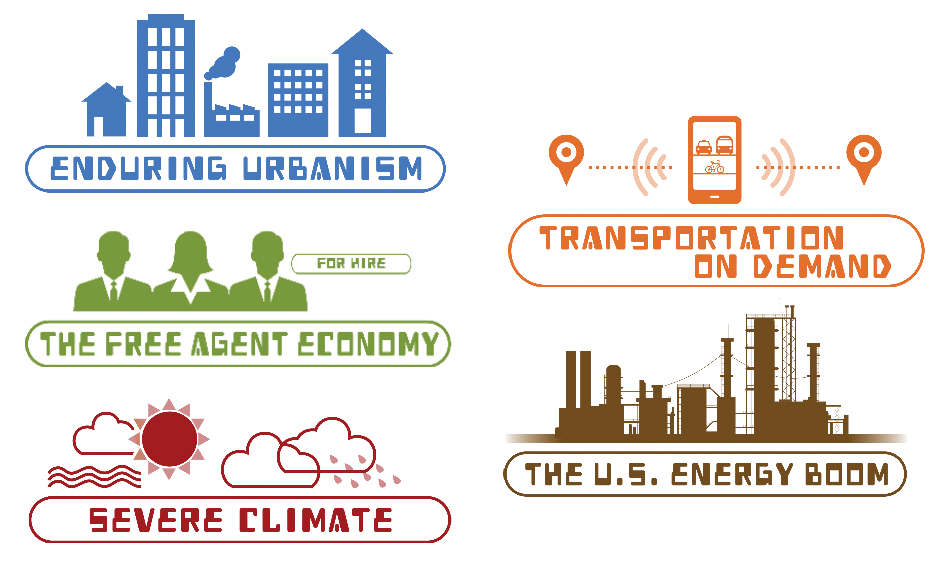
The DVRPC has identified five Future Forces as having a regional impact through 2045. Credit: DVRPC.
NJ PEN: One of the major planning functions of the DVRPC is to forecast how the region will change in the coming decades.
We’ve spoken about what the Philly metro area used to look like some 30 years ago.
What do you think the next 30 will hold?
SEYMOUR: Well, we’ll find out!
Our latest plan, which we adopted last year, has a target date of 2050. We’re already almost 30 years out there. Planners tend to sometimes live in the future in some ways, and that’s our job to imagine what forces are coming, and what change is going to look like, and to try to be prepared and get ahead of that.
Having said that, we only know what we know, and COVID is a great example of those wild cards that get thrown at you. When we did the 2050 plan, we had brainstormed a series of potential Future Forces that could impact the region. One of them was a global pandemic. And it was identified as high-impact but low likelihood. Go figure. But at least our folks were thinking broadly, and had identified that.
The first thing that I worked on when I started at DVRPC was the long-range plan, and at that point, it was a plan for the year 2020. So as we began the 2050 plan, I was able to go back and pull out the 2020 plan to see how we did. It was really instructive.
At that point, we’d forecasted that even though the city of Philadelphia had been losing population, that’s going to start to turn the corner, and after 2000, the city would start to see growth again — and that happened.
At a policy level, we talked about how we need to invest in our cities, in our communities, with existing infrastructure, to help them grow and come back. We changed our portfolio to stop investing in new highways, and start investing in transit and communities. We talked a lot about suburban sprawl and farmland, and we saw a lot of the counties step up to start to preserve open space out in the suburbs. We didn’t get everything right, but I think we were pretty well on target.
NJ PEN: Are there any predictions that you think you really nailed?
SEYMOUR: In the 2020 plan, which was done in 1990, people were talking about climate change and global warming, and the impact of CO2 on the atmosphere; even sea level rise. But nobody had really seen those impacts yet. It was hard to push that agenda too much at that time because it was just not as widely accepted as it is now.
Our plan talks about climate change, both in terms of how do we reduce greenhouse gas emissions and also climate resiliency. Even if we completely turned around our energy systems tomorrow, those built-in emissions of CO2 will still have impact in terms of flooding and extreme weather.
Another big one we talked about was around the idea of equity, which today, has certainly, in a really good way, come very much to the forefront of people’s thinking. It’s about being sure that all communities are recognized and supported; that all people have opportunities; that the investments we make and others make are really very deliberate around trying to bring everyone up.
I think this idea of sustainability — which has become a little bit of a catchword — around broader means of environmental protection, and being more deliberate around that, [also is] certainly at the forefront.
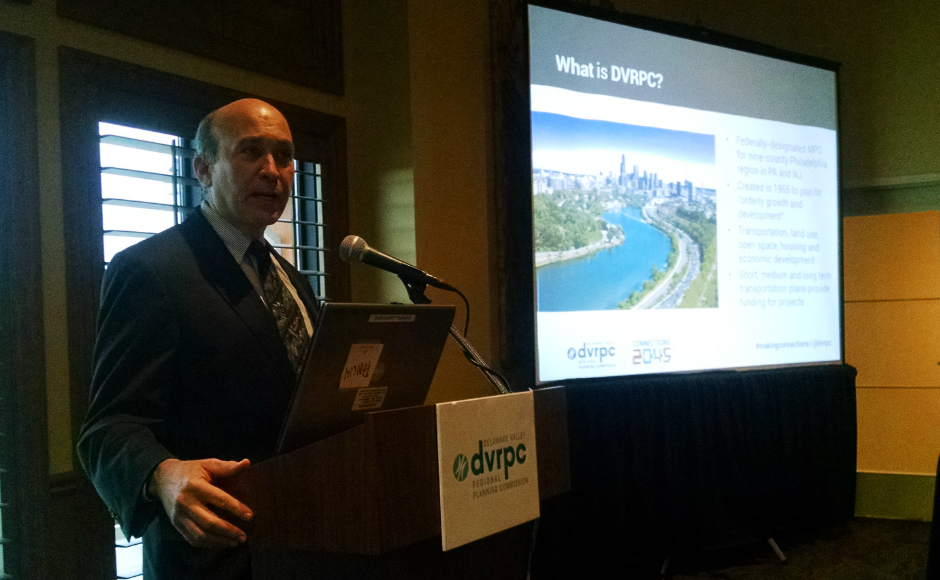
DVRPC Executive Director Barry Seymour speaks at the Camden County Boathouse in 2016. Credit: Matt Skoufalos.
NJ PEN: When you consider what goes into doing your job as an organizational leader, what kinds of qualities or person do you think DVRPC should seek in your successor?
SEYMOUR: So much of what we do is around relationships.
DVRPC is really about partnerships, and we’re affected not by force of regulation, or ownership and management of facilities, but through partnerships, advocacy, technical assistance, and providing good advice.
Whoever takes over my seat needs to be engaged across the region with a wide variety of people and organizations. They need to keep that board camaraderie together, which I’m sure they will. I’m sure those board members have that in their DNA now. They have a great staff that all know what they’re doing, and that are smart and creative, and continue to do their work.
And we’ll see what emerges. Part of doing this job is there’s been a continual grouping of new activities and new issues that have come to the forefront, and that’s what’s made it interesting for me these years. I gave the board my thoughts on what the job is, and what it takes to do the job, but at the end of the day, the board selects my replacement.
NJ PEN: If you could leave the region (or your successor) with some advice, or a takeaway from your time at DVRPC, what would it be?
SEYMOUR: I think your work in this field, as a planner, whether it’s at a regional or at a local agency — you’ve got to be patient. Things don’t happen immediately, they happen over time, and I’ve been in the same place long enough to see those changes and that’s been rewarding.
You need to work with a wide range of people. You need to be a good listener. I do a lot of public speaking, but I try to do a lot of listening also. You need a sense of humor, because you can’t take yourself or the world too, too seriously.
And that idea of a regional identity is really important. The places that have done well around the country are the ones that come together in a true, cooperative approach. D.C., Virginia, and Maryland may hate each other, but when it comes time to go after Amazon, or work together on a big project, the do that.
My office is in Philadelphia, but Camden is across the river. It’s way closer than West Philly or Montgomery County. The river shouldn’t be a barrier that separates us. Everybody roots for the Eagles; everybody should come together and root for the greater Philadelphia region.


